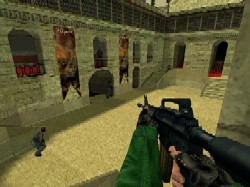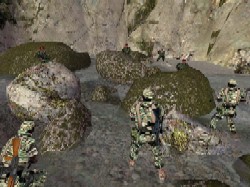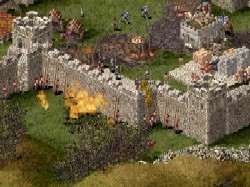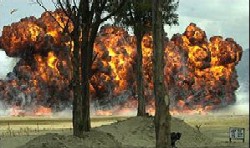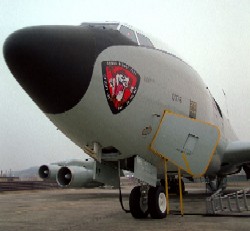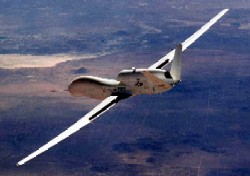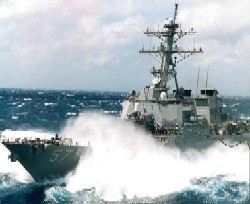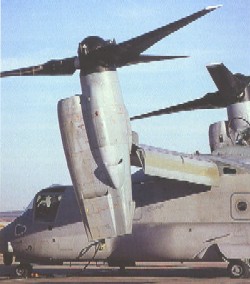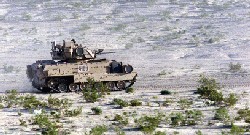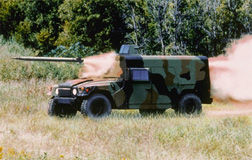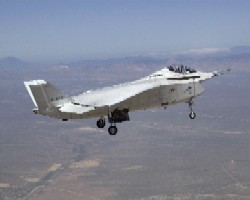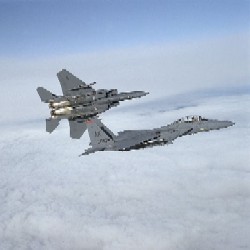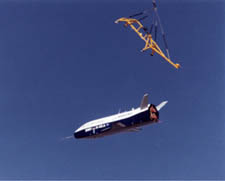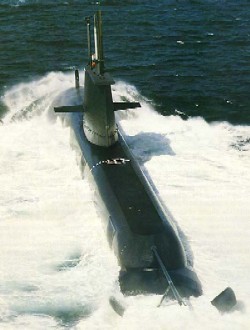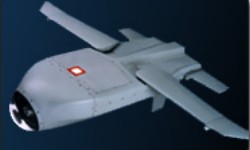Page 1
Daily News
By Gail Helmer
| Send Us News | Archives | Main |
Friday, April 20, 2001
PC News
- COMBATSIM.COM Forum Gets A Facelift
- Global Operations Website Launched
- GodGames Stronghold Revealed
- NVIDIA Completes Purchase of 3dfx
- Taiwan Simulates Invasion By The Chinese
- Unique Aircraft Disappears From New Mexico
- Global Hawk Prepares For Deployment To Australia
- South Florida Air & Sea Show
- Navy To Commission Guided Missile Destroyer Lassen
- France test fires M45 missile
COMBATSIM.COM Forum Gets A Facelift
It had to be done. We've upgraded to the all-power accessorized UBB version 6.This version is a HUGE improvement over the 5 series not only on the user side, but also on the admin and server resources side.
On the user side, there's lots of new features: the ability to send private messages is one, the formatting options in the message creation screen is another. I've also turned on the email notifications for everybody. Now you don't have to go through me to get your password if you've forgotten it.
On the server side, the biggest change is the elimination of static HTML pages. Until now, every thread created a static HTML page on the server. This made harddrive disk space always a worry and made formatting updates to the board a sheer nightmare. Now, all the pages are displayed dynamically.
Downsides? Well, I'm pretty sure all the links from our articles to the article feedback forum topics are now pooched, but the improvements were worth the loss (we will fix those busted links eventually).
I, like you, am really new to this new board system, so I too will also be learning as we go. I just hope it's a welcome improvement to you all. Click here to check out the new forum.
Global Operations Website Launched
Crave Studios has launched the official website for Global Operations. Developed by Barking Dog Studios and published by Crave Entertainment, Global Operations is an action game with highly realistic weapons and backdrops built from the ground up for the multiplayer experience. With a wide variety of mission styles, including hostage rescue, bomb defusing, territory control, VIP escort, base destruction, assassination, and assault/defend.
"Global Operations'" specialty system allows individual characters to excel in specific roles. Every specialty, including sniper, commando, and demolition expert, is compatible with all weaponry, but specialized arms enhance accuracy and effectiveness. Therefore, one of the key elements of the game is deploying a well-balanced squad. Even in death, teamwork is invaluable. The game's reinforcement feature gathers eliminated players together in helicopters and armored personnel carriers before reinserting them in the game. In this unique "waiting room", teammates have an opportunity to converse and strategize before returning to the battlefield as a reinforcing squad. Click here to visit the website.
Features for "Global Operation" include:
GodGames Stronghold Revealed
- An SDK for mod authors and the mapping community will be made available at the time of release or shortly afterwards.
- 16 diverse real-world locations based on current and past well-known armed conflicts
- 32 elite fighting forces based on real world special forces, peace keepers, rebel groups, guerilla forces, and terrorist groups
- 36 real weapons: 8 handguns, 6 sub-machine guns, 4 shotguns, 4 machine guns, 8 assault rifles, and 6 sniper rifles
- 7 customizable specialties to reinforce team roles
GodGames and FireFly Studios have revealed details on FireFly Studios Stronghold. Set in Medieval Europe, Stronghold challenges players? strategic building, resource management and RTS combat skills. Stronghold players become the rulers of a virtual medieval world with each decision and policy they implement.
Players work to build and protect their castle and ultimately will mount an invasion to dominate the enemy's fortress. A campaign-style storyline develops through narrative and in-game interaction. Stronghold?s multiplayer mode supports up to eight players over the Gamespy Internet gaming service and LAN connections. Players can choose to compete in the multiplayer mode for control over their respective castles or work together on the same castle, assigning control over aspects such as troops and resources management in a cooperative mode. Release Date: October 2001
NVIDIA Completes Purchase of 3dfx
NVIDIA announced that its wholly owned subsidiary, NVIDIA US Investment Company, completed its purchase of certain graphics assets of 3dfx Interactive. On December 15, 2000, NVIDIA US Investment Company, NVIDIA and 3dfx signed an asset purchase agreement for NVIDIA US Investment Company to purchase from 3dfx certain graphics assets, which include, but are not limited to, patents, patent applications, trademarks, brand names and other graphics related assets. At the closing, NVIDIA US Investment Company paid $55 million in cash to 3dfx. Subject to the satisfaction of certain additional conditions, 3dfx may receive additional consideration from NVIDIA US Investment Company in the form of cash and/or shares of Common Stock of NVIDIA Corporation. As a result of today's closing, the patent infringement litigation between NVIDIA Corporation and 3dfx will be jointly dismissed with prejudice.
Military News
Taiwan Simulates Invasion By The Chinese
Thousands of Taiwanese troops have carried out a live-firing exercise before the world's media, repelling a simulated invasion by the Chinese along the island's southern coast. On Haiko beach in southern Taiwan, combined army, navy and air forces fought off a simulated Chinese landing. An artillery barrage pounded targets in the sea. Taiwanese-made missiles were launched from land batteries and helicopters fired Hellfire missiles bought from the US.
The show of firepower was part of a series of exercises that include simulated computer battles and cyber-warfare tests. Similar war games last year were scaled down for fear of provoking China. Taiwan also unveiled a new multi-barrelled rocket launcher, called Thunder 2000. A decision is expected from Washington next week on the sale of new weaponry to Taiwan. Click here to view the video of the Taiwanese live-firing exercise.(AP Photo)
Unique Aircraft Disappears From New Mexico
A unique flying research laboratory disappeared from New Mexico on April 18. The C-135E aircraft, known as Argus and sporting its distinctive Tasmanian devil nose décor, was flown to the Aerospace Maintenance and Regeneration Center at Davis-Monthan Air Force Base, Ariz., where it will be stored to await its final disposition. It flew its last data-gathering mission last summer, conducting atmospheric tests for the airborne laser program.
The Argus flight test program was a unique opportunity for the Air Force Research Laboratory, allowing its highly skilled scientists and engineers to take technological developments from the laboratory and test them in the field, according to Capt. Craig Phillips, Argus mission operations chief. This flying research laboratory not only supported the Department of Defense but also the National Aeronautics and Space Administration, the Department of Energy and the airborne laser system program office.
"Its biggest capability was to provide a low-cost airborne platform for research and development," Phillips said. "Flight costs were very competitive with others because of Air Force flight and operations crews."
It was the only Air Force C-135E capable of flying extended missions up to 50,000 feet above the Earth's surface making it unique in the Air Force inventory, according to Phillips.
The Argus program officially began in 1986 to collect data on rocket plume phenomena, re-entry vehicle signatures, kill assessments and sensor checkout for the Strategic Defense Initiative Organization, the forerunner to the Ballistic Missile Defense Organization. The program and aircraft are named after a many-eyed vigilant Greek mythological character who could see everything.
Phillips said one of its most important missions was to conduct treaty verification flights for the Defense Nuclear Agency in 1990. Major upgrades that year qualified it for ultraviolet, visible, mid-wave and long-wave infrared imaging and spectroscopy.
The current aircraft arrived here in 1990 and was owned and operated by Detachment 2 of the 452nd flight Test Squadron. The Air Force Research Laboratory directed energy directorate's active remote sensing branch of the advanced optics and imaging division managed the data gathering and analysis program. Although the 40-year-old aircraft may have left Kirtland, the mission may remain here, said Lt. Col. Christopher S. Washer, branch chief. "We are exploring leasing aircraft from other programs here as there will always be a need for our expertise," he said.
Global Hawk Prepares For Deployment To Australia
The U.S. Air Force's Global Hawk unmanned reconnaissance system is expected to set an aviation record on Sunday, April 22, when it crosses the Pacific Ocean, flying nonstop from Edwards AFB, Calif., to Edinburg Air Base in Australia. Northrop Grumman Corporation's Integrated Systems Sector (ISS) is the prime contractor for Global Hawk.
According to the Air Force Flight Test Center at Edwards AFB, this flight would be the first time that an unmanned, powered aircraft will have crossed the world's largest ocean. The flight will last nearly 24 hours. Global Hawk is deploying to Australia to continue advanced flight testing and to participate in a number of joint American and Australian military demonstrations during the next six weeks, including the annual Tandem Thrust exercise.
Northrop Grumman was recently awarded a $6 million cost-plus/fixed-fee contract from the U.S. Air Force for performance of demonstration missions by the Global Hawk as part of this deployment. Work under the contract will be performed in San Diego, Calif., and at locations in Australia. "We are looking forward to working with the United States and Australian armed services on this unique joint demonstration of the capabilies of the Global Hawk system," said Carl Johnson, Northrop Grumman Global Hawk program manager. The Global Hawk program successfully completed its Milestone II decision in a Defense Acquisition Board review on Feb. 16, 2001. Completion of Milestone II allowed the program to enter the EMD phase.
South Florida Air & Sea Show
The Air & Sea Show will feature two of the most popular jet demonstration teams -- the U.S. Air Force Thunderbirds and the Canadian Forces Snowbirds. The show is one of the world's largest spectator events, drawing more than three million people over two days to a four-mile stretch of city's beach. The event is part of "A National Salute to the U.S. Military," and kicks off the USO's National Military Appreciation Month in May. "The USO is truly proud to be a part of this great event as we continue to support the morale and well-being of our men and women in uniform," said General John H. Tilleli, Jr., USO President and CEO.
This year the Air & Sea Show is combined with the Broward Navy days Fleet Week, that runs from April 30 through May 7. "South Florida's individual and corporate support has made Fleet Week in Port Everglades one of our nation's premier events of its kind, and now with the opportunity to join up with the Air & Sea Show, our community will have the greatest ever 'national salute to the U.S. military,'" said Joe Millsaps, Chairman of Broward Navy Days. Click here to visit the Air Show website.
Navy To Commission Guided Missile Destroyer Lassen
The Department of the Navy will commission Arleigh Burke class guided-missile destroyer Lassen (DDG 80) Saturday, April 21, 2001, during an 11 a.m. EST ceremony at the Florida Aquarium Pier in Tampa, Fla. The ship is named in honor of Navy Cmdr. Clyde Everett Lassen, a native of Fort Myers, Fla., (1942-1994), who received the Medal of Honor for his courageous rescue of two downed aviators while commander of a search and rescue helicopter in Vietnam.
On June 19, 1968, Lassen, a lieutenant flying a UH-2 Seasprite helicopter, made several attempts to recover the pilots, but dense tree cover, enemy fire, and intermittent illumination conspired to frustrate his efforts. Determined to complete his mission, Lassen turned on the landing lights of his helicopter despite the danger of revealing his position to the enemy. After the pilots made their way to the helicopter, Lassen, his bullet-riddled helicopter dangerously low on fuel, evaded further anti-aircraft fire before landing safely on a guided missile destroyer, the USS Jouett (DLG 29). Lassen became the first naval aviator to be awarded the Medal of Honor for bravery in Vietnam. One previous Navy ship named Lassen (AE 3) (1941-1947), an ammunition ship named for the volcanic peak in the Volcanic National Park, Calif., received three battle stars during World War II.
Lassen is the 32nd ship of 58 Arleigh Burke class destroyers currently authorized by Congress. These highly-capable multi-mission ships can conduct a variety of operations, from peacetime presence and crisis management to sea control and power projection, in support of the National Military Strategy.The mission of Lassen is to conduct sustained combat operations at sea. The ship is capable of fighting air, surface, and subsurface battles simultaneously. It is equipped with the AN/SPY-1D phased array radar, the most powerful air search radar in Navy's inventory. The ship contains myriad offensive and defensive weapons designed to support maritime defense needs well into the 21st century.
Cmdr. Sean O'Connor, a native of Rumson, N.J., is the commanding officer of Lassen. With a crew of 32 officers, and 348 chiefs and enlisted personnel, Lassen will be homeported in San Diego, Calif., as a member of the U.S. Pacific Fleet. The ship was built by Litton Ingalls Shipbuilding in Pascagoula, Miss., and is 513 feet in length and has four gas-turbine engines which power the 9,238 ton ship to speeds in excess of 30 knots.
France test fires M45 missile
The French defence procurement agency DGA and the French Navy have carried our a successful test firing of an M45 missile, to test and assess, under operational conditions, measurement and test equipment that will be used on the next generation of strategic missiles, the M51.
The test also verified systems aboard the nuclear submarine Inflexible. The test took place on Tuesday night, when the Inflexible, positioned off the Quimper naval base, launched the missile across the Atlantic to its impact area off the coast of Guyana.
DGA scientists monitored the missile and its environment throughout the flight. Technicians from DCN, CEA, EADS and the French Navy used radars at different locations on the West coast of France and close to the impact area gathered telemetry for further analysis and study
The test was designed to test new technologies under real conditions and to help select the best materials and equipment for the M51 strategic ballistic missile, for which the French Government signed a euro 2.85 billion development contract at the end of last year.
Thursday, April 19, 2001
Flanker Beta 3 V2.51 Released.
- Flanker Beta 3 V2.51 Released.
- E3 2001 To Unveil Hundreds of New Games
- Astronics Lands F-16 Option
- Upgraded Su-25 'Scorpion,'At Paris Airshow In June 2001
- MV-22 Programme Troubled But Saveable
- Power Of Digitisation Proves Worth During Capstone
SSI has released the Beta 3 of V2.51. The file is 1.5 MB. Please remember that this is a Beta and may have problems. SSI has asked for your help with verification the the areas mentioned in the Read Me file (see below) are indeed addressed properly in this patch. Please assist them by reporting any problems you encounter with V2.51 Beta 2 and verification that previous problems have or have not been addressed. POST RESULTS HERE
Download V2.51 Beta 3
Since you need Beta 2 for Beta 3 to work properly (you also need to start with V2.5) here is the link for V2.51 Beta 2
Make sure you unzip the file to your Flanker 2.0 directory and ensure that you unzip with the directory structure intact. SSI has included the Joystick.exe utility that was suppose to be in the Beta 2 ZIP file.
Flanker V2.51 Beta 3 Read Me File:
To run properly, the Flanker 2.51 Beta 3 patch requires both Flanker 2.5 and Flanker 2.51 Beta 2 to have been previously installed.
New in Beta 3 patch
Installation instructions
- Different game controllers supported via DirectX 8 (joysticks, wheels, throttles, game pads, pedals etc.). DirectX 8 installation is incumbent now. You MUST use DirectX 8.
- The Murena to Neustrashimy transformation problem is removed (it was not actually removed in Beta 2, sorry).
- F-15 drop tanks are now oriented properly.
E3 2001 To Unveil Hundreds of New Games
- Unzip the archive. Make sure that the files are placed in the proper directories
- Flanker.exe belongs in the Flanker 2.0 home directory.
- F15-PTB.cmd belongs in the Flanker 2.0/Bazar/World/Shapes directory.
More than 750 never-before-seen computer, online and video games and related products will debut at the 2001 Electronic Entertainment Expo (E3), according the Interactive Digital Software Association (IDSA).Overall, about 400 companies, including 123 first-time E3 exhibitors, will showcase thousands of games and products at this year's show, which will be held May 17 to 19 at the Los Angeles Convention Center.
90 percent of the game titles being shown have been developed for families and children. Nineteen percent of titles have been published specifically for women and girls, and about eight percent for seniors. 40 percent of never-before-seen game titles at E3 2001 have been developed for consoles, more than one-third have been developed for computer CD ROM, approximately 15 percent for handheld devices and almost four percent for online/Internet only games.
"So, if you want to know what the more than 60 percent of Americans who play computer and video games will be asking for this holiday season, you need to be at E3, the world's most important forum for the launch of interactive entertainment products and technologies." Said Douglas Lowenstein, president of the IDSA, the trade association representing U.S. entertainment software publishers.
Military News
Astronics Lands F-16 Option
Astronics Corporation ( today announced that the U.S. Air Force has exercised the final option on its contract to provide night vision lighting upgrade kits for the USAF fleet of F-16 aircraft. The option calls for deliveries worth over $10 million.
The contract, originally awarded in 1998, included an initial award and three additional options. By exercising all of the options the Air Force has purchased lighting kits to modify over 1,000 aircraft. When deliveries are complete in late 2002, the program will be worth over $50 million in Astronics shipments. The company has delivered approximately 40% of the kits thus far.
"This award confirms the US Air Force's pleasure with our performance on this ambitious program. It is an endorsement of our capabilities that they have exercised all of the options," said James Kramer, a Vice President at Astronics' Luminescent Systems subsidiary.
Upgraded Su-25 'Scorpion,'At Paris Airshow In June 2001
Elbit Systems Ltd., the defense electronics company, and TAM, the Georgian aircraft manufacturer, today jointly announced the upgrading of the Su-25 aircraft with an advanced avionics system including Weapon Delivery and Navigation System (WDNS). The upgraded Su-25 "Scorpion" made its official maiden flight today at the TAM airfield in Tbilisi, Georgia. The flight ceremony was attended by Eduard Shevardnadze, the president of Georgia, senior government and military officials and representatives from Elbit Systems and TAM.
The Su-25 is a Close Air Support (CAS) aircraft that can carry a variety of weapons on ten underwing pylons. The upgraded Su-25 "Scorpion" is equipped with advanced systems complying with ICAO requirements. A state-of-the-art cockpit with two, 6 X 8 inch, multi-colored LCD displays and a Head-Up Display (HUD) had offered enhanced situational awareness and all-weather capabilities. This expands the operational use of the Su-25 and enhances flight safety. The new avionics system provides accurate navigation and precise weapon delivery capabilities and is designed to handle both Eastern-type and Western-type weapons and pods. The "Scorpion" brings the Su-25 operational performance and versatility to a standard, which fits the requirements of the modern battlefield and the needs of potential customers.
The Su-25 "Scorpion" will be displayed in flight and on the ground at the Paris Air Show in June 2001. TAM, the original manufacturer of the Su-25, has produced more than 800 aircraft that are in use by many customers.
MV-22 Programme Troubled But Saveable
The investigation into the MV-22 crash that killed 23 US Marines has concluded that the programme should continue, but that it is not yet close to being deployable. Panel leader Norman Augustine, former Chairman of Lockheed Martin, said at a press conference that "The V-22 is probably the best answer available but it's not ready today, though, for operational use-- not close to it."
The panel acknowledged that the aircraft, which can hover like a helicopter and then, by swivelling its engine, fly like an aircraft, was the best alternative to replace the US Marine Corps ageing helicopter fleet, buts there were several design faults that would require a phased approach to rectify. Causes of the latest crash in December that killed four marines included a frayed hydraulic line and a software error.
Commandant of the US Marine Corps General James Jones said in a statement in response to the panel's decision that he was encouraged by the findings. "This is a capability our nation needs to meet the operational requirements of the 21st century," the statement said.
The panel also considered whether the programme should be scrapped, but concluded that too much had been spent already. So far $12 billion has been spent, and eight aircraft delivered. Over 450 are planned at an additional cost of $29 billion. However the programme still has to survive the 'root and branch' review of all major Pentagon programmes ordered by the Bush administration. The panel's findings will be presented to Secretary of Defense Donald Rumsfeld on Tuesday.
Power Of Digitisation Proves Worth During Capstone
The US 4th Infantry Division (Mechanised) has completed its field test of the US battlefield digitisation system in a series of exercises at the National Training Centre (NTC) in California during the Division Capstone Exercise (DCX) in early April. Although the dust is just beginning to settle in the manoeuvre box from the exercise, the Army is deciding how to apply what was learned. Initial reports indicate the soldiers from Fort Hood, Texas, were able to operate with greater initiative, adapting quickly to changing situations to manoeuvre and fight throughout harsh day and night weather conditions in the high Mojave Desert. A key to their battlefield success was use of advanced information technology in the form of a distributed tactical Internet.
A Bradley Infantry Fighting Vehicle with soldiers of the 4th ID rolls into the desert to begin the Division Capstone Exercise. (photo by Spc. Johnny A. Thompson.)
Battles during the DCX demonstrated that Army Battle Command Systems (ABCS), commonly referred to as digital information systems, were able to empower soldiers to "move more quickly over the extended battlespace," said Brig. Gen. James D. Thurman, NTC commander. "The Division Capstone Exercise clearly demonstrated what well trained and competent leaders can do when they leverage information and use it as an element of combat power."
After the Gulf War, the Army began a focused effort to explore the potential of enhancing combat capability with advanced information technologies. This digitisation effort began in earnest in 1994 with the Army's first advanced warfighting exercise at the National Training Centre, DESERT HAMMER. Soon after, the 4th Infantry Division was designated as the Army's experimental division for advanced warfighting concepts. Subsequent combat training, materiel development, and further field experimentation, have led to a range of improvements in organisation, doctrine, combat platforms, and information systems, culminating in the DCX.
"The DCX provided us with a continuous operation in a tactical environment to challenge our communication systems, our digital systems, and our war fighting systems, against a very, very competent OPFOR," said Maj. Gen. Ben Griffin, commander, 4th Infantry Division. "We were able to maximise our weapons systems to gain situational dominance."
Commanders agreed that the Army's investment in developing the ABCS, along with doctrinal, organisational, and materiel system upgrades, enhances the division's ability to fight. The units were able to achieve their training objectives and now possess a formidable go-to-war capability.
"The DCX was an example of what the future holds," said Col. Robert Cone, commander, 2nd Brigade, 4th Infantry Division. "In our quest to get the systems functioning the way they were designed to perform, we have been through various stages. We've been through the crawl and walk stages, and we worked out the frailties of the systems. We are now at the run stage."
"No one is going to come out of this mission saying the digital systems were perfect. There were some shortcomings," said Col. Jim Barclay, commander, 4th Brigade, 4th Infantry Division. "But we have knowledgeable and capable soldiers who learn quickly and are able to successfully use the new systems. The digital systems are not perfect, but as a commander I saw a clear picture of what was going on in the battlefield and I was able to make quicker and better decisions than before. The systems aren't completely there yet, but we are a long, long way ahead. The DCX was a overwhelming success."
A key to the division's enhanced battlefield dominance was demonstrated through their gaining situational understanding to develop battlefield situations.
"The DCX provided us with a continuous operation in a tactical environment to challenge our communication systems, our digital systems, and our war-fighting systems, against a very, very competent OPFOR," said Maj. Gen. Ben Griffin, commander, 4th Infantry Division. "We were able to maximise our weapons systems to gain situational dominance."
Wednesday, April 18, 2001
PC News
Space Empires: IV Patch 1.35 Released!
Shrapnel Games announced today that they have released a new patch for their intergalactic space conquest game, Space Empires: IV. This current patch has enhanced the game further by adding a Map Editor, new command line options, as well as fixing and tweaking certain aspects of the game. Click here to download the patch.
P-61B Released for CFS2 And FS2000.
Abacus Publishing has announced the release of Designer Dave Eckert P-61 for CFS2 and FS2000. Dave has visited the Mid-Atlantic Aviation Museum in Pennsylvania twice to make sure that the close-up details of his Black Widow add-on are accurate. Special instrumentation have been added by Robert Clark, Arne Bartels and Bill Rambow and authentic radial engine sounds by Mike Hambly. The P-61B Black Widow is now ready for your test flight. It's the newest member of Abacus Publishing's large Premier Collection. Click here to download and test fly Dave's P-61B.
FLY! II Goes Gold.
GodGames announced today that Terminal Reality's FLY! II, the sequel to the general aviation simulation FLY!, has gone gold. FLY! II features new and expanded 3D models, aircraft, elevation scenery and higher resolution images. FLY! II also includes more points of interest, improved visual effects, dynamic environments and thorough tutorials, instructions and assistance for beginners
Tuesday, April 17, 2001
PC News
- Soldier Of Fortune 2 Announced
- Matrox Releases Win2K Drivers
- The Matrox Marvel G450 Now Shipping
- L-3 Display System For LOSAT Programme
- Indra Leopard Turret Simulators For Spanish Army
Soldier Of Fortune 2 Announced
Activision, Inc. and Raven Software have announced the development of Soldier of Fortune 2 for the PC. In Soldier of Fortune 2 players once again assume the role of John Mullins, a military consultant working for the top-secret anti-terrorist group known as The Shop. In the game, players must tackle a wide-range of missions from hostage rescue and intelligence gathering, to search-and-destroy. Level design in Soldier of Fortune 2 is flexible enough to allow for multiple styles of play. Gamers can "hit 'em hard" with a frontal assault or use stealth weapons for a subtle approach.
The backbone of Soldier of Fortune 2 is a highly integrated system of technologies. Environments in the game are created with the QUAKE III Arena engine, widely considered the most advanced 3D engine in gaming. Additionally, Soldier of Fortune 2's new GHOUL II technology brings the grittiness of combat to the PC like never before with incredibly detailed skeletal animations that enable lifelike character movements and per pixel hit locations for ultra realistic damage modeling. Finally, Soldier of Fortune 2 features an all-new ROAM Terrain System that allows players to ride and fight from armored trucks and helicopters.
Soldier of Fortune 2 is slated for release Winter 2001.
Matrox Releases Win2K Drivers
Matrox has just released an updated Win2K drivers for their Millenium G400 and G450.Click here for more information and to download drivers.
Main Fixes:
The Matrox Marvel G450 Now Shipping
- DX Diag now reports AGP texturing is enabled.
- Fixed no output of real media via DVD Max.
- Fixed windows Roll up feature.
- Fixed missing menu screens when running Softimage at 1280x1024x32bit.
- Improved high CPU usage when DVDmax is enabled.
- Fixed Pro/DESKTOP corruption resizing workspace when using objects defined from the object palette.
- Fixed problem with X-plane not loading.
- Fixed text corruption problem with Unigraphics V17.0.
- Fixed Oni premature exit.
Matrox graphics Inc. today announced that the Matrox Marvel G450 eTV, the most comprehensive all-in-one graphics card for consumers is now available from the Matrox's online store. Marvel G450 eTV gives users the power to do it all, from watching timeshifted TV on the PC to uploading streaming video on the Web. In addition, the Marvel G450 eTV features stereo TV tuning, MPEG2 video capture and playback, S-video and composite input/output, high-quality DVD playback, hardware acceleration for 2D/3D applications, and Matrox's revolutionary DualHead® technology.
Combining DualHead with a software package that includes Ulead® VideoStudioTM 4.0 for the Marvel G450 eTV, home users can easily edit video footage into home movies by adding titles, transitions, voice-overs and music, while simultaneously viewing the changes full-screen on TV. In addition, the Marvel G450 eTV also bundles the Matrox PC-VCR 2.0, Matrox Software DVD Player, Ulead® Photo ExplorerTM 6.0, closed captioning (North America), and a teletext browser (Europe). The Marvel G450 eTV supports Microsoft® Windows® 98, Windows 2000, or Windows Millennium Edition.
Military News
L-3 Display System For LOSAT Programme
L-3 Communications' Display Systems division has been awarded a contract from Lockheed Martin Missiles and Fire Control to provide the Display System for the Line-of-Sight Anti-Tank Programme (LOSAT). The contract is valued at approximately $2 million, plus production options for a total potential of over $6 million.
The LOSAT Weapon System is comprised of a hypervelocity Kinetic Energy Missile (KEM) and associated fire control system integrated into an expanded capacity High Mobility Multipurpose Wheeled Vehicle. LOSAT is an air-droppable system with overwhelming KEM lethality against advanced armour, bunkers, and hardened structures.
Each Display System consists of a Controls & Displays Manager (CDM) and 2 BattleView/15 Tactical Displays. The system provides both the operator and commander the means to locate, identify and engage targets.
L-3 Display Systems developed the BattleView/15 to meet the military's needs for ruggedised, lightweight, tactical, high-resolution displays for vehicle operators on the battlefield. L-3's LOSAT Display System is based on the latest Active Matrix Liquid Crystal Display (AMLCD) flat panel technology, advanced processors, software and interfaces.
"The inclusion of this hardware in the LOSAT System provides the ability to view high resolution video and tactical information crucial for all operators on the complex digital battlefield,'' said Bob McGill, president of L-3 Display Systems. (Lockheed Martin Photo)
Indra Leopard Turret Simulators For Spanish Army
Indra, a Spanish Information Technologies company, has been awarded a 6,350 million pesetas (US$33.65 million) contract by the Spanish Ministry of Defence for the development, manufacturing and supply of nine turret simulators for the Leopard tank, which will be installed at sites throughout the country.
These simulators will be used to train crews in the handling of the sophisticated turret of this latest generation tank. The Ministry of Defence plans to award a second batch of gunnery and driving simulators in the near future, for which Indra has proposed an advanced technology and performance solution. Indra is also developing the complex gun-aiming systems.
Indra leads the consortium set up for the development and supply of simulators for the future Eurofighter and enjoys a significant presence in the United States as the only non-American supplier of simulators for the US Navy.
Monday, April 16, 2001
PC News
- SSI Announces Harpoon 4 Is Back
- Flanker Beta 2 Of V2.51 Released
- IL-2 Sturmovik Development Update
- EAW Scenario Sighted Main Body Released
- TAR2.5 Texture Management Utility Released
- Boeing Completes First JSF In-Flight Conversions To STOVL
- Boeing, USAF Finalize Deal For 10 More F-15E Aircraft
- Collins Class HMI Incorporated In US Nuclear Submarines
- Lockheed Martin's Redesign For LOCAAS Air Weapon
- Rolls-Royce Announces Dedicated US Marine Organisation
SSI Announces Harpoon 4 Is Back
Ubi Soft, after consideration and feedback from users and the development team, have decided to resurrect and finish Harpoon 4. An official statement is expected later this afternoon.
Flanker Beta 2 Of V2.51 Released
The Beta 2 release of V2.51 is now available for downloading. The file is 12 MB. Please remember that this is a Beta and may have problems. SSI asks for your help with verification in the areas mentioned in the Read Me file (see below) are indeed addressed properly in this patch. Also, please assist them by reporting any problems you encounter with V2.51 Beta 2 to the following message thread: POST RESULTS HERE
To download the V2.51 Beta 2 files Click here. Make sure you unzip the file to your Flanker 2.0 directory and ensure that you unzip with the directory structure.
Flanker V2.51 Beta 2 Read Me File:
Flanker 2.51 Beta 2 includes Beta 1 corrections.
Flanker 2.51 accesses joystick data via DirectX 8. Throttle is Slider 0 now. Joy2Key features are updated. Do not remove old joy2key.ini with buttons mapping and your other custom data! Joystick failure diagnostics in the Error.log is now expanded. New joystick drivers have been upgraded. Reinstallation and reconfiguration after Windows or DirectX upgrade are highly recommended. Separate Microsoft DirectX 8 Joystick.exe utility has been included with this patch. This program helps to test joystick functionality with DirectX 8 without having to run Flanker.
FIXES:
IL-2 Sturmovik Development Update.
- Gun pipper and funnel are now at V2.03a standards.
- Mini-HUD displays target data now. (NOTE: Target data on HUD, NOT mini-HUD change from Read Me file in ZIP download.)
- Speed, altitude and bank data are displayed in SETKA mode. (Key command "8")
- Multiplayer track recording is now fixed.
- Multiplayer games are more stable.
- Graphics problems with the Kuznetzov aircraft carrier textures have been fixed.
- MiG-29K ailerons now exhibit correct motion when viewed externally.
- Mig-29K is more stable.
- Some of the Mig-29 level of detail (LOD)problems have been corrected.
- MiG-29 External fuel tanks consume fuel first and fuel indicator does not show any main fuel consumption until the external tanks are empty.
- Landing touch down sound has been restored.
- Movement after belly landings is now restricted.
- Murena to Neustrashimy graphics problem has been fixed.
- "Press 'S' to Start" message is now properly formatted in English.
- Old tracks may be incompatible with new objects behavior. At present, the Training Missions do not work with V2.51. We are still investigating this problem.
This week Oleg Maddox has posted screenshots including a 3D thunderstorm, details of the FW-190A-4 cockpit, the final cockpit of the Yak-7 amd Yak-1B . Click Here to check out the latest.
EAW Scenario Sighted Main Body Released
Version 1.0 of the EAW scenario Sighted Main Body: The Battles at Midway Island 3rd-5th June 1942 has been released and is available for download. Click here to download.
TAR2.5 Texture Management Utility Released.
The new TAR2.5 texture management utility has been released with many new features including the ability to automatically convert old Flanker 2.03 schemes to Flanker 2.5x compatible schemes. To commemorate the release TAR2.5 includes the FJFS MiG29K Enhanced Cockpit. Click here.
Military News
Boeing Completes First JSF In-Flight Conversions To STOVL Mode
In what veteran test pilot Dennis O'Donoghue called "the best day of my flying career," the Boeing Joint Strike Fighter X-32B Friday successfully completed its first in-flight conversions - from conventional to short-takeoff-and-vertical landing (STOVL) flight mode and back again. The milestone marks the beginning of flight test of the Boeing direct-lift solution to the customer's STOVL requirement.
On the aircraft's third test flight, O'Donoghue, the company's lead STOVL test pilot, demonstrated the first flow-switch transition, re-directing the X-32B's engine thrust from the cruise nozzle to its lift nozzles and then back again. The transition was accomplished at 180 knots and 9,500 feet during the 58-minute flight.
Later the same day on the aircraft's fourth flight, O'Donoghue completed seven flow-switch transitions at speeds ranging from 140 to 185 knots and altitudes between 6,000 and 9,500 feet. The aircraft spent approximately 40 minutes of the 52-minute flight in the STOVL mode. Semi-jetborne handling qualities tests including throttle transients and lift-nozzle thrust vectoring also were completed during the flights. O'Donoghue said the conversions between conventional and STOVL flight modes were extremely smooth.
"Today's testing confirmed the ease in conversion between conventional and STOVL flight modes as well as the low pilot workload required," O'Donoghue said. "Ease of operation and the ability to rapidly convert to and from conventional and STOVL modes gives the pilot tremendous operational flexibility and are key advantages of direct lift.
"The flow-switch transitions from cruise nozzle to lift nozzles and back again took approximately three seconds, which reinforces the data we collected in our simulations, on the engine test stand and during X-32B ground tests," he added.
A former U.S. Marine Corps Harrier pilot, O'Donoghue added that he continued to be impressed with the handling qualities of the X-32B. "The plane flies just like the simulator. That's significant because we're closely matching actual performance with what we predicted in years of modeling and simulation."
Maj. Jeff Karnes, U.S. Marine Corps, also a Harrier pilot, became the first Marine to fly the X-32B when he piloted the aircraft on its second flight April 11. Karnes is part of an integrated test team that includes One Team and U.S. and United Kingdom government test pilots and engineers.
The X-32B will complete a number of flights at Edwards before moving to Naval Air Station Patuxent River, Md., for the majority of STOVL testing. The overall flight-test program will include approximately 55 flights totaling about 40 hours.
Boeing, USAF Finalize Deal For 10 More F-15E Aircraft.
The Boeing Company and U.S. Air Force have finalized contract terms for 10 F-15E aircraft, which will sustain production of the world's best multi-role fighter into 2004. Last year, Boeing began building the planes with initial funding from the Air Force's fiscal year 2000 budget. The aircraft will have several upgrades that make them the most capable F-15Es delivered to date.
Valued at approximately $571.1 million, the contract covers airframes and certain other components. The Air Force will purchase some items separately such as engines as it has in the past. The planes will be the 227th-236th F-15Es produced at the Boeing facility here. Deliveries start during the first half of 2002 and will extend through the last quarter of 2004.
Boeing is upgrading the airplanes' programmable armament control set (PACS) and software so the F-15E can fully utilize the Joint Direct Attack Munition, Joint Standoff Weapon and Wind Corrected Munition Dispenser. The planes will also receive enhanced night-vision capability and three new active-matrix liquid crystal displays. Those displays are more reliable and maintainable than the cathode-ray tube displays in previous aircraft.
Boeing has offered the Republic of Korea an F-15E derivative the F-15K -for the FX fighter competition. Korea is to select its new fighter later this year.
Successful X-40A Free Flight Major Accomplishment for X-37
The X-40A glided to the runway at Edwards Air Force Base in California, its nose wheel set down smoothly, and the test vehicle rolled to a gentle stop, but no pilot exited the craft, for there was no pilot. The X-40A flew itself, guided by its on-board systems. "It was truly a beautiful sight, and cause for celebration," said Susan Turner, NASA's X-37 program manager at Marshall Space Flight Center in Huntsville, Ala.
The X-40A's free flight and landing was conducted as part of the X-37 program, intended to reduce the risk of flight testing the X-37, not from 15,000 feet (about 4.6 kilometers) like the X-40A, but from low Earth orbit. The X-37 is an experimental re-entry vehicle that will enable NASA to test advanced technologies in the harsh environment of space and in returning through Earth's atmosphere.
This first successful test of the X-40A by NASA was a big step forward for the X-37 program. Its primary objective was to validate the vehicle's Computed Air Data Systems (CADS), which also will be used in the flight control system of the X-37. The X-37 program consists of three phases of flight testing: the X-40A free flight series is phase one; phase two begins with X-37 unpowered flights; and phase three will be the orbital test flights.
"Incremental testing is a cost-effective approach to designing an experimental spacecraft," said Turner. "By leveraging an existing asset the X-40A we obtain valuable information which enhances the likelihood of mission success for the X-37. "Upcoming free flights will push the envelope further. Each time, we'll change some of the test variables of the X-40A to check the vehicle's controllability and maneuverability in a different flight situation. The results will help us determine our safety parameters when we fly the X-37."
A second free flight test of the X-40A is scheduled for early April. The objectives are the same as the first flight, however, engineers will modify control variables to see how the vehicle responds.
Collins Class HMI Incorporated In US Nuclear Submarines
Elements of the Human Machine Interface (HMI) software developed for Australia's Collins Class submarines have been installed on US nuclear submarines. Raytheon's Naval & Maritime Integrated Systems (N&MIS) has been a tailoring a command and control system, CCS Mk2, as the replacement combat system for the Collins Class submarine. Developed for the US navy the combat system was tailored to suit the crew size of the Collins and the Royal Australian Navy's concept of operations for their diesel submarines. The most significant change made to CCS MK2 was the HMI.
As the management and mitigation of risk were high priorities for the Collins project, Raytheon established a HMI and Risk Reduction Laboratory (HMIRRL) in Sydney. Through this laboratory, specialists from N&MIS, Raytheon Australia and Raytheon's partner, Thomson Marconi Sonar Pty, were able to make the necessary changes.
The HMIRRL demonstration was seen by visiting senior US Navy submariners who were very impressed by the changes Raytheon had made in such a short time period. The Collins HMI improvements were then incorporated into a CCS MK2 build that has since been installed on three USN submarines, and is planned to be incorporated on all Los Angeles and Virginia class submarines.
Lockheed Martin's Redesign For LOCAAS Air Weapon
Lockheed Martin's Akron and Dallas units have combined their weapons systems expertise to offer the Vertical Launch Autonomous Attack System (VLAAS) to navies for ship defence and surf zone bombardment during operations in littoral regions. Navies currently possess limited stand-off capabilities to defend against fast patrol boats and to deliver time-critical, precision-strike ashore. VLAAS would perform both missions. VLAAS is the result of configuring the vertical launch payload delivery system, supplied by Lockheed Martin Naval Electronics & Surveillance Systems, Akron, Ohio, to accept the low-cost Autonomous Attack System (LOCAAS) munition, now in development at Lockheed Martin Missiles and Fire Control, Dallas.
"Extending the capabilities of the vertical launch payload delivery system by loading it with other munitions gives navies an already qualified booster system that integrates into the existing Mk-41 vertical launching system. Our engineers have demonstrated the compatibility of this vertical launch and LOCAAS combination to the in-place launching hardware and fire control systems," said Chuck Carlise, director of business development tactical systems.
The proven vertical launch ASROC rocket motor and guidance system would boost LOCAAS into a ballistic flight, extending the range of the onboard munitions for surface attack and ship protection. With its guidance system and manoeuvrability, LOCAAS munitions would select high-value targets to attack. LOCAAS can loiter over a 25-nmi2 flight pattern at a speed of 215 knots.
LOCAAS, a guided and powered munition, has a range of more than 100 nautical miles. It was designed to detect and destroy mobile land targets. Once released, LOCAAS acquires global positioning data, flies to a target area and then searches the target area for high-value targets. It can either acquire a target for immediate attack or loiter above the area until a suitable target is identified. It is fitted with an inertial navigation system/global positioning system, automatic target recognition, and a programmable multimode warhead.
It is intended that VLAAS would give ship commanders an urgent-attack capability and establish an umbrella of loitering munitions to protect ships when threatened by fast-attack patrol boats. When dispersed from VLAAS, LOCAAS munitions would loiter over an area, acquire a target, and then attack it by powered flight and with guided accuracy.
"The initial LOCAAS design was for aircraft delivery. However, this application for naval defence leverages our work with munition dispensers, and simply uses another proven launching system to give navies a better solution for a very real threat. The system will work as well for navies as it will for air forces," said Al Carney, director-business development for naval munitions, at Lockheed Martin Missiles and Fire Control, Dallas.(Lockheed Martin Photo)
Rolls-Royce Announces Dedicated US Marine Organisation
Rolls Royce has unveiled the structure of a dedicated US marine organisation to provide the complete range of products and services to the US Navy, US Coast Guard and naval defence contractors in the shipbuilding and ship maintenance business. The Rolls-Royce facility in Walpole, MA, (formerly the Bird-Johnson Company) has been designated as the lead site for Rolls-Royce Naval Marine, Inc. in North America.
Rolls-Royce believes its naval business in the US will continue to grow as customers increasingly look to companies that can provide equipment and systems or service packages from a single source -simplifying the supply chain, enabling greater product integration and reducing costs and risk. Since the acquisition of Vickers plc in 1999, Rolls-Royce marine capabilities have grown significantly and the company now offers a wide ranging portfolio, including gas turbines, propellers, podded propulsors, waterjets, stabilisers, steering gear and deck handling equipment.
Saul Lanyado, President, said: "We are a global company serving 30 navies world-wide, but the ability to offer local support is crucial to our success. This new role for our Walpole facility is part of that strategy. "
The Smart Propulsor Product Model program, a contract with the US Navy's Naval Sea Systems Command, is an example of this partnering approach. Rolls-Royce Naval Marine is using its design and manufacturing experience to evaluate cost impacts of propulsor designs in a virtual environment. Last month, Northrop Grumman and Rolls-Royce plc were awarded a contract worth approximately $120 million by prime contractor BAE Systems to supply 12 WR-21 marine gas turbine packages for the first six ships of a new twelve ship fleet of Type 45 air defence destroyers for the Royal Navy.
| Send Us News | Archives | Main |
